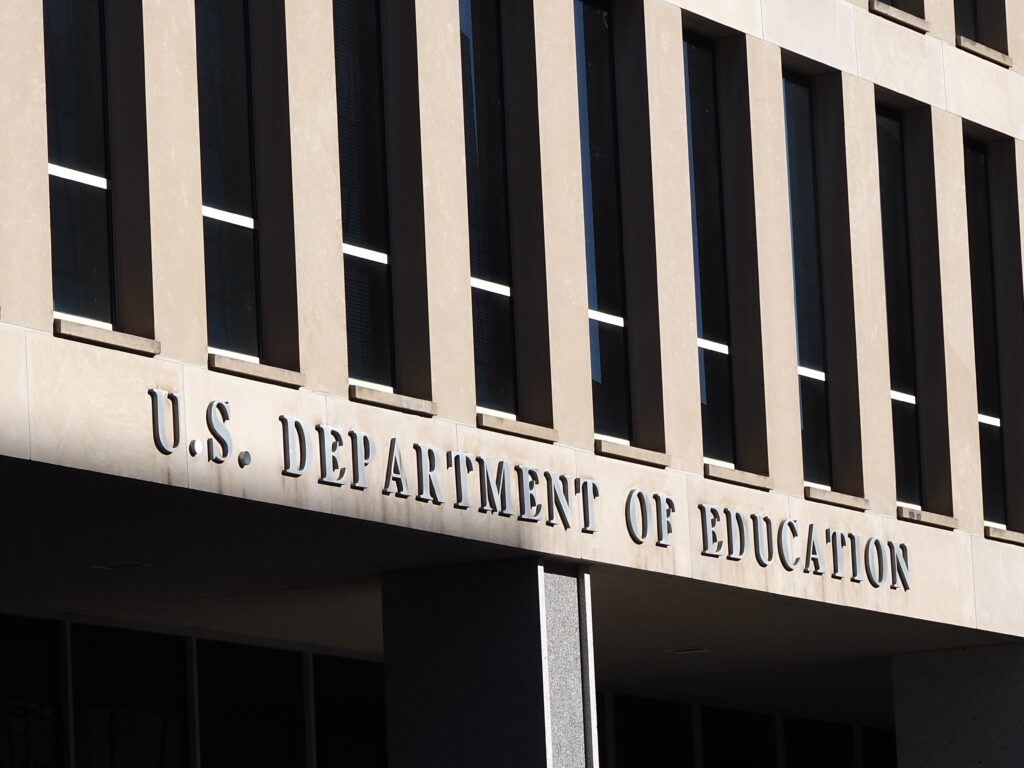
The Lyndon Baines Johnson Department of Education Building pictured on Nov. 25, 2024. (Shauneen Miranda/States Newsroom)
WASHINGTON — President-elect Donald Trump’s pledge to get rid of the U.S. Department of Education will be far easier said than done.
As Trump seeks to redefine U.S. education policy, the complex logistics, bipartisan congressional approval and redirection of federal programs required make dismantling the department a challenging — not impossible — feat.
It’s an effort that experts say is unlikely to gain traction in Congress and, if enacted, would create roadblocks for how Trump seeks to implement the rest of his wide-ranging education agenda.
“I struggle to wrap my mind around how you get such a bill through Congress that sort of defunds the agency or eliminates the agency,” Derek Black, an education law and policy expert and law professor at the University of South Carolina Joseph F. Rice School of Law, told States Newsroom.
“What you can see more easily is that maybe you give the agency less money, maybe you shrink its footprint, maybe we’ve got an (Office for Civil Rights) that still enforces all these laws, but instead of however many employees they have now, they have fewer employees,” Black, who directs the school’s Constitutional Law Center, added.
What does the department do?
Education is decentralized in the United States, and the federal Education Department has no say in the curriculum of public schools. Much of the funding and oversight of schools occurs at the state and local levels.
Still, the department has leverage through funding a variety of programs, such as for low-income school districts and special education, as well as administering federal student aid.
Axing the department would require those programs be unwound or assigned to other federal agencies to administer, according to Rachel Perera, a fellow in Governance Studies in the Brown Center on Education Policy at the Brookings Institution.
Perera, who studies inequality in K-12 education, expressed concern over whether other departments would get additional resources and staffing to take on significantly more portfolios of work if current Education Department programs were transferred to them.
Sen. Mike Rounds introduced a bill last week that seeks to abolish the department and transfer existing programs to other federal agencies.
In a statement, the South Dakota Republican said “the federal Department of Education has never educated a single student, and it’s long past time to end this bureaucratic Department that causes more harm than good.”
The Heritage Foundation’s Project 2025 proposed a detailed plan on how the department could be dismantled through the reorganization of existing programs to other agencies and the elimination of the programs the project deems “ineffective or duplicative.”
Though Trump has repeatedly disavowed the conservative blueprint, some former members of his administration helped write it.
The agenda also calls for restoring state and local control over education funding, and notes that “as Washington begins to downsize its intervention in education, existing funding should be sent to states as grants over which they have full control, enabling states to put federal funding toward any lawful education purpose under state law.”
Title I, one of the major funding programs the department administers, provides billions of dollars to school districts with high percentages of students who come from low-income families.
Black pointed to an entire “regulatory regime” that’s built around these funds.
“That regime can’t just disappear unless Title I money also disappears, which could happen, but if you think about Title I money — our rural states, our red states — depend on that money just as much, if not more, than the other states,” he said. “The idea that we would take that money away from those schools — I don’t think there’s any actual political appetite for that.”
‘Inherent logical inconsistencies’
Trump recently tapped Linda McMahon — a co-chair of his transition team, Small Business Administration head during his first term and former World Wrestling Entertainment CEO — as his nominee for Education secretary.
If confirmed, she will play a crucial role in carrying out his education plans, which include promoting universal school choice and parental rights, moving education “back to the states” and ending “wokeness” in education.
Trump is threatening to cut federal funding for schools that teach “critical race theory,” “gender ideology” or “other inappropriate racial, sexual, or political content on our children,” according to his plan.
On the flip side, he wants to boost funding for states and school districts that adhere to certain policy directives.
That list includes districts that: adopt a “Parental Bill of Rights that includes complete curriculum transparency, and a form of universal school choice;” get rid of “teacher tenure” for grades K-12 and adopt “merit pay;” have parents hold the direct elections of school principals; and drastically reduce the number of school administrators.
But basing funding decisions on district-level policy choices would require the kind of federal involvement in education that Trump is pushing against.
Perera described seeing “inherent logical inconsistencies” in Trump’s education plan.
While he is talking about dismantling the department and sending education “back to the states,” he’s “also talking about leveraging the powers of the department to punish school districts for ‘political indoctrination,’” she said.
“He can’t do that if you are unwinding the federal role in K-12 schools,” she said.

